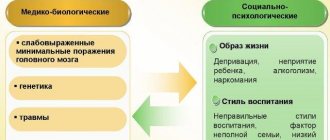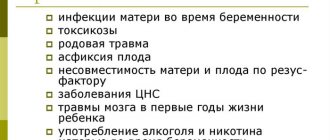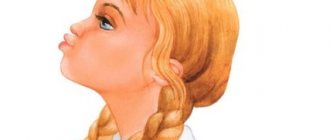Dysarthria is a name for speech disorders caused by damage to the central nervous system.
The disorder is characterized by a decrease in the mobility of the speech apparatus, as a result articulation suffers. Dysarthria in children can cause incorrect pronunciation of words, writing and reading disorders, as well as general underdevelopment of speech, or its complete absence. Among various speech therapy pathologies, dysarthria ranks second in prevalence, only dyslalia is more common. Therefore, today much attention of specialists and parents is paid to this speech disorder.
Reasons for development
Dysarthria is not an independent disease, although often this speech disorder is the main manifestation of various pathologies of the central nervous system. In most cases (up to 85%), dysarthria accompanies cerebral palsy. Malformations of the nervous system can be caused by a variety of reasons:
- pathological conditions of the fetus during intrauterine development. These include severe toxicosis and the pathological course of pregnancy, chronic maternal diseases and intrauterine infections, hypoxia, asphyxia or ischemia of the fetal brain, Rh conflict, etc.;
- genetic predisposition (presence of severe hereditary pathologies);
- head injuries and illnesses suffered by a child in the first few years of life. These include hydrocephalus, meningitis and other neuroinfections, purulent otitis media, as well as poisoning with toxic substances and intoxication due to infectious diseases.
The above reasons lead to damage to the parts of the brain that control movement, the cerebellum, basal ganglia, brain stem, nerve fibers and their connections with muscles.
Manifestations of dysarthria are different, and they depend on which part of the central nervous system is affected.
Diagnostics
Examination of children with dysarthria requires the comprehensive participation of specialists. This is primarily a neuralgic diagnosis, so children require observation by a neurologist.
Neurologist
First of all, the doctor collects anamnesis: the course of pregnancy and childbirth, features of the first year of life and the development of the child. After which a visual inspection is carried out. Much attention is paid to the state of muscle tone. An EEG (electroencephalography) and, if possible, an MRI are prescribed. Such examinations provide an opportunity to get an idea of the state of the brain.
Clinical manifestations will be visible as early as 3 years. Therefore, in order to successfully cure the disease, it is necessary not to delay a visit to a neurologist. Only he can make a diagnosis.
Speech therapist
The speech therapist’s task is to conduct an examination of all aspects of speech. To begin with, the state of articulatory motor skills at rest is determined. To do this, the facial muscles are examined:
- is there hyperkinesis?
- condition of nasolabial folds;
- lip position
The ability to frown, raise eyebrows, smile, lower the corners of the lips, open and close the mouth is tested. Movements are learned through active games. Attention is paid to the study of all speech sounds - for this, the child is shown pictures where the same sound is in different positions.
The articulatory apparatus is examined. Children in the preparatory group are given tasks for sound analysis (determining the place of a sound in a word).
Main features
If a child has a speech disorder such as dysarthria, then his articulatory muscles will be in a state of hypotonia. This makes speech unclear and also causes other problems caused by bulbar disorders.
Among the most common symptoms of dysarthria are the following:
- The lips are in an open state, the tongue spontaneously falls out.
- Lips closed too tightly. This manifestation is caused by spasm of the muscles of the articulatory apparatus.
- Flaccid or inactive tongue (with dystonia of articulatory muscles).
- Problems with swallowing and chewing food, excessive salivation and inability to swallow food, as well as other bulbar disorders.
- Speech development at an early age does not correspond to the norm (the baby does not babble, the first words appear after 2 years, etc.).
- The child does not suffer from ENT diseases, but still speaks through his nose. Nasal tint occurs due to low mobility of the palate. The air stream does not encounter any obstacles on its path and freely enters the nasal passages.
- Improper speech breathing, difficulty pronouncing long phrases, frequent pauses in speech, etc.
- The speech lacks melody, it is too drawn out or, conversely, fast.
- Distortion, substitution or omission of sounds.
- Too high, squeaky voice.
- Impaired fine motor skills. Dysarthria in children is manifested by the inability to fasten buttons, reluctance to assemble small construction sets, etc.
In severe forms of dysarthria due to paralysis of the speech muscles, complete muteness may be observed. This condition is called anarthria.
All manifestations of dysarthria are usually very persistent and difficult to correct.
Classification
There are several options for classifying childhood dysarthria. The most common of them is associated with the localization of a pathological focus that affects the functioning of the speech center. The following forms of the disease are distinguished:
- pseudobulbar (most common);
- bulbar;
- extrapyramidal (subcortical);
- cerebellar;
- cortical.
Depending on the degree of damage and the severity of the main symptoms, the following forms of dysarthria are distinguished:
- erased: characterized by minimal pronunciation disorders;
- moderate: severe articulation defects, slurred speech, quiet voice;
- anarthria: complete absence of speech or isolated sounds.
Types of dysarthria
There are several ways to classify this speech disorder. Clinical forms of dysarthria are distinguished based on which areas and parts of the central nervous system were affected:
- bulbar occurs when the medulla oblongata is damaged. The name comes from the Latin word bulbus, which translates as onion. This is the shape of the medulla oblongata. This section of the central nervous system is responsible for the functioning of the cranial nerves that ensure the functioning of the tongue and pharynx. There are practically no voiced sounds in speech; pronunciation takes on a nasal tone. With the bulbar form of dysarthria, not only speech disorders are observed. Paralysis of the muscles of the larynx and pharynx leads to difficulties in swallowing food, especially solid and liquid, it is very difficult for the child to chew, emotions are not displayed on the face;
- subcortical is caused by damage to the subcortical nodes of the brain. The main manifestation of pathology in this case is a violation of muscle tone, as well as involuntary contractions of facial and articulatory muscles. As a rule, such movements are especially noticeable when the child is talking, but they can also be observed at rest. Because muscle tone is constantly changing, a child's speech may be completely normal at times. However, at the moment of articulatory spasm, he is not able to utter even a few sounds. Due to such a sharp switching of articulatory movements, speech intelligibility suffers, the timbre and strength of the voice are disrupted. In some cases, subcortical dysarthria is accompanied by hearing loss, which further complicates speech pathology;
- cerebellar in its pure form is rare in children. Various pathologies of the cerebellum lead to speech becoming scanned. During a conversation, the child continually shouts out individual sounds;
- cortical is a form of the disease that is difficult to isolate and recognize. The manifestations of coccal dysarthria are very similar to motor alalia. In both cases, voluntary motor skills of the articulatory apparatus and the pronunciation of words with a complex sound-syllable structure are disrupted. However, with cortical dysarthria there are no violations of the lexico-grammatical aspect of speech. The child experiences difficulty switching from one articulatory position to another. Therefore, he pronounces individual sounds clearly, but in speech there is no automation of them;
- pseudobulbar is a form of dysarthria often found in children. It is this type of disorder that occurs due to damage to the central nervous system during the development of the fetus in the womb, at the time of birth or in the first years of the child’s life. Paralysis occurs as a result of damage to the pathways that carry nerve impulses from the cerebral cortex to the nuclei of the hypoglossal, vagus and glossopharyngeal nerves. The clinical manifestations of the pathology are similar to bulbar dysarthria, however, the pseudobulbar form is easier to correct.
Pseudobulbar dysarthria
This form, in turn, is conventionally divided into three degrees, based on the severity of the pathology. A mild degree of pathology is not associated with gross violations of the motor skills of the articulatory apparatus. Such a child has slow tongue movements and they are not precise enough. There are no problems with chewing and swallowing, sometimes choking is possible.
Speech is often slow, sounds are blurred, especially those that are complex in articulation (zh, sh, r, ts, ch). When pronouncing voiced sounds, there is insufficient participation of the voice; difficulties also arise when pronouncing soft sounds, since the rise of the middle part of the tongue towards the hard palate is added to the main articulatory posture.
Sound disorders often lead to the child experiencing difficulties in analyzing sounds, phonemic development suffers, and errors may occur when writing. At the same time, there is practically no violation of grammatical structure, vocabulary and word structure. That is, with a mild form of pseudobulbar dysarthria, the child experiences phonetic-phonemic underdevelopment (FFN) of speech; other signs of pathology can be detected only with a thorough examination.
If the child’s mental development and hearing are not affected, then regular classes with a speech therapist at a clinic or educational institution will help correct the situation.
Mild forms of pseudobulbar dysarthria, as well as severe ones, are rare. The largest group consists of children with moderate pathology. First of all, they are distinguished by their amicability: due to paralysis of the facial muscles, the child cannot puff out his cheeks, close or stretch his lips.
Limited tongue movements are also noticeable: the child is unable to hold it in one position, turn it to the sides or lift it. It is very difficult to transition from sound to sound when changing articulatory postures; due to the sedentary palate, the voice takes on a nasal tint. Speech is very slurred, since the lips are inactive and often closed, others have difficulty understanding the child.
This degree of pseudobulbar dysarthria greatly complicates the child’s learning process at school, so such children are often recommended classes in specialized institutions where an individual approach to students with this speech disorder is practiced.
The severe form of pseudobulbar dysarthria is called anarthria. This is complete inactivity of the speech apparatus against the background of deep muscle damage. A child with this form of disorder has a constantly open mouth, the lower jaw droops, and the face looks like a mask. Speech may contain individual sounds, but more often it is completely absent.
Extreme dysarthria is a severe speech disorder that is difficult to correct. However, in the absence of mental disabilities, the child can be educated in specialized schools. Classes with a speech therapist, based on special techniques, will allow such a child to successfully master writing skills and gain knowledge in basic school subjects.
As mentioned above, the division into degrees of severity is quite arbitrary; no one has established clear boundaries between these conditions. What all these forms of speech disorder have in common is that the distortion of sounds does not affect the rhythmic contour of the word. That is, the child pronounces words with different numbers of syllables and observes stress. But when there is a combination of consonants, the child may “lose” one sound, for example, a squirrel will turn into a bek, etc.
In addition, difficulties in transitioning from one sound to another leads to the replacement of consonants. Instead of the word “scissors” the child will say no-si-sy. The tongue remains in one articulatory position, characteristic for the pronunciation of the sound “S”, and does not move for the correct pronunciation of the sounds “Zh” and “C”.
Dysarthric children often have problems with sound analysis. They are unlikely to pass the generally accepted tests that determine the level of this skill. A third-grader with this speech disorder will find, for example, four sounds in the word “cat”: K, A, T, A. When selecting pictures depicting words starting with the sound “B”, this child will also select words starting with the sound “P” etc.
Symptoms
There are different types of dysarthria, but their main symptoms are similar - problems with gross and fine motor skills, breathing problems, and voice problems. There are problems with both consonants and vowels. Sound pronunciation defects are conventionally divided into two groups: distortion and absence (or replacement) of sound.
First of all, the child’s articulatory motor skills suffer. In this case, increased or decreased muscle tone is observed. With hypertonicity, the tongue is pulled deeper into the mouth, the back is raised, and the tip does not work well. If there are problems with the orbicularis muscle, the lips are compressed and their movements are limited.
With hypotonicity, the tongue is flattened and weak, the lips are limp and not closed. This is often accompanied by hypersalivation.
With dysarthria, the pronunciation of hissing, whistling, and sonorant sounds suffers. Children often experience interdental pronunciation - the tip of the tongue sticks between the teeth.
Due to disruption of the functioning of nerve endings and the transmission of impulses to the brain, children do not feel well the movements of the tongue and lips, so they find it difficult to switch positions.
Symptoms of dysarthria
Treatment of dysarthria
Since dysarthria can be a manifestation of a variety of nervous system disorders, there is no single treatment regimen for this pathology. The child, first of all, should be examined by a neurologist. He also carries out the treatment. Classes with a speech therapist are auxiliary in this case; they are part of a complex of treatment measures, which also includes:
- drug treatment. After making a clinical diagnosis, the neuropathologist determines the order of treatment measures, prescribes medications, etc. All this is carried out taking into account the severity of the underlying neurological disease, as well as the age of the child. It should be remembered that there is no pill for dysarthria . The medications used in therapy eliminate the main symptoms of the pathology and alleviate the condition of the small patient, making him more susceptible to other methods of correction;
- massage. Manual procedures can reduce the severity of muscle paralysis;
- breathing exercises. Dysarthric children often experience difficulties with speech breathing. Special exercises help them learn to control the exhaled flow, which allows them to normalize the tempo and rhythm of speech;
- physiotherapy.
If you notice symptoms of dysarthria in your child, you should contact a specialist as soon as possible. The sooner doctors and speech therapists begin to deal with dysarthric, the higher the chance of normalizing speech and avoiding difficulties with learning at school.
Even a mild form of dysarthria requires correction, primarily due to the fact that the child himself feels constrained. He is aware of the mistakes in his speech and is offended when others do not understand him. All this leads to the fact that a dysarthric child withdraws into himself and completely stops communicating with the people around him.
Work to normalize speech should be carried out not just by a speech therapist, but by a speech pathologist with sufficient qualifications and experience. When correcting dysarthria, special speech therapy techniques are used, without knowledge of which it is impossible to help a dysarthric child. And, of course, a speech pathologist must have great patience and endurance, because correction of dysarthria is usually difficult and takes a lot of time. The child may not make contact, refuse to complete the proposed tasks, or perform them incorrectly.
Despite all the efforts of specialists, in some cases the correction does not bring the desired results. The reason for this may be problems in the family. For a child to speak, he must be surrounded with love and care. Parental support is of great importance.
Prevention
Quite often, parents of children suffering from dysarthria blame themselves. But this speech disorder in many cases develops for reasons beyond a person’s control. No doctor can predict the development of dysarthria in the prenatal period, but a pregnant woman’s compliance with these rules will reduce the risk of developing all kinds of central nervous system pathologies:
- Timely consultation with a doctor and registration. In modern medicine, it is customary to monitor a woman throughout the entire period of pregnancy. With the help of various studies, doctors assess the condition of the fetus, reduce the risks of developing various pathologies, etc. But many women neglect this, turn to specialists late or do not register at all. The development of pathology is difficult to predict, but it can be noticed in time and appropriate measures taken. The sooner this is done, the higher the chance of having a healthy baby.
- Proper nutrition and giving up bad habits. No matter how trivial it may sound, this aspect is very important for the health of not only the expectant mother, but also her baby. In order for the fetus to form correctly, it is necessary to provide the body with a sufficient amount of useful microelements. Taking medications, alcohol-containing drinks and smoking can make unwanted adjustments to the process of formation of vital organs and the central nervous system. It is especially important to monitor your diet during the first trimester of pregnancy.
- Refuse to visit public places for a while, especially during periods of increased incidence of influenza and other infectious diseases.
Avoid stress, spend more time outdoors, try to get as many positive emotions as possible!
To prevent the development of dysarthria in early childhood, it is necessary to provide the child with proper care. Head injuries and all kinds of diseases, especially infectious ones, undermine the baby’s health and negatively affect his development.
Be attentive to yourself and your child, your health is in your hands!





